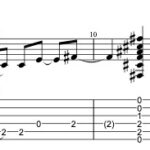The D minor 7 chord, often represented as Dm7, brings a unique flavor to the family of minor chords. While sharing the somber essence of the regular Dm chord, the Dm7 introduces a captivating twist with its added seventh interval. This subtle addition imbues the chord with a sense of yearning and unresolved emotion, making it sound almost inquisitive.
Characterized by its melancholic yet thoughtful nature, the Dm7 chord evokes feelings of contemplation and gentle unease. Its sophisticated sound profile makes it an excellent choice for adding depth and complexity to chord progressions, particularly within blues and jazz contexts.
Let’s delve into the construction of the Dm7 chord, explore popular ways to play it on the guitar, and discover iconic songs that feature its distinctive sound.
Decoding the Dm7 Chord: Notes and Construction
The Dm7 chord builds upon the foundation of the D minor chord, which comprises the notes D, F, and A. To transform it into a Dm7, we introduce the seventh interval, the note C. This added note is what gives the Dm7 chord its characteristic color and emotional depth.
Therefore, when you strum a Dm7 chord, you are harmonizing these four notes:
D, F, A, and C
Exploring Different Voicings: Playing the Dm7 Chord on Guitar
Guitarists often employ various fingerings to play the same chord, each resulting in a slightly different sonic texture. For the Dm7 chord, two positions stand out as particularly useful and common: the open position Dm7, known for its warm, resonant tone and beginner-friendliness, and the 10th position Dm7, situated higher up the fretboard for a brighter and more cutting sound.
The Accessible Open Position Dm7 Chord
The open position Dm7 chord is widely favored due to its relative ease of playing and rich, full sound. This voicing is an excellent starting point for guitarists venturing into minor 7th chords. To form the open Dm7, position your fingers as follows:
- Index finger: 1st fret of the B string (2nd string)
- Index finger: 1st fret of the high E string (1st string)
- Middle finger: 2nd fret of the G string (3rd string)
Strum only the top four strings, starting from the D string (4th string) downwards.
The Higher-Pitched 10th Position Dm7 Chord
Once you’ve become comfortable with the open position, the 10th position Dm7 offers a brighter and more powerful alternative. This voicing, played higher on the neck, is perfect for adding a different tonal color to your playing. To play the Dm7 in the 10th position:
- Barre your index finger across all six strings at the 10th fret.
- Place your ring finger on the 12th fret of the A string (5th string).
Strum all six strings from the low E string (6th string) downwards.
Dm7 Chord in Music: Genre-Spanning Versatility
The Dm7 chord’s adaptable nature allows it to seamlessly integrate into diverse musical styles. While it’s a minor chord with a seventh, its sonic character is less overtly somber than some of its minor counterparts. Instead, the seventh interval lends it a nuanced, almost questioning quality, making it a valuable tool for songwriters and composers across various genres. You can hear the Dm7 chord adding its unique touch to pop hits, funky grooves, and especially blues compositions.
Dm7 in Pop Anthems
The Supremes’ timeless classic, “Baby Love,” released in 1964, showcases the Dm7 chord within a catchy Motown framework. The song’s enduring appeal stems from its blend of lush vocal harmonies and a rich, almost orchestral arrangement. The Dm7 chord plays a crucial role in creating a compelling contrast between the upbeat melody and the rhythmic foundation, enhanced by an intriguing chord progression and prominent brass instrumentation.
Dm7 in Funk Rhythms
Ripple’s funk gem, “I Don’t Know What It Is, But It Sure Is Funky,” cleverly incorporates the Dm7 chord in its higher 10th position barre chord form. This infectious track is a prime example of vintage funk, driven by a slick bassline and vibrant horn section. The Dm7 adds a touch of sophistication to the groove, making it irresistible to move to.
Dm7 in Blues Melodies
The Dm7 chord is practically a signature element in blues music, appearing in countless songs across generations.
Marvin Gaye’s soulful masterpiece, “Inner City Blues,” exemplifies the Dm7’s power to create musical tension and emotional depth. Starting with a heartbeat-like rhythm, the song builds into a powerful commentary, with the Dm7 chord underpinning the intensity of Gaye’s lyrics about societal struggles. Released in 1971, its message remains strikingly relevant even today.
Switching gears to contemporary blues, Robert Cray’s poignant track, “Phone Booth,” masterfully uses the Dm7 to convey melancholy and introspection. The song’s narrative of desperation and loneliness, symbolized by a call from a phone booth, perfectly encapsulates the emotional nuance of the Dm7 chord.
Even in more upbeat contexts, the Dm7 can add a touch of soulful depth. Bruno Mars’ chart-topping hit, “Just the Way You Are,” demonstrates this versatility. While the verses are energetic and optimistic, the chorus, with its powerful progression, utilizes the Dm7 to create a moment of heartfelt sincerity and emotional resonance.
Ready to explore more musical horizons? Dive into songs that resonate with your personal style and start incorporating the Dm7 chord into your playing.
To expand your chord vocabulary further, explore Fender Play’s comprehensive chord library, learn about various chord types, and access valuable tips for mastering them.
If you’re new to Fender Play, sign up for a free trial today and unlock a world of guitar learning!
Loading…

